NVIDIA GeForce GTX 770 Review: The $400 Fight
by Ryan Smith on May 30, 2013 9:00 AM ESTPower, Temperature, & Noise
As always, last but not least is our look at power, temperature, and noise. Next to price and performance of course, these are some of the most important aspects of a GPU, due in large part to the impact of noise. All things considered, a loud card is undesirable unless there’s a sufficiently good reason – or sufficiently good performance – to ignore the noise.
GTX 770 ends up being an interesting case study in all 3 factors due to the fact that NVIDIA is pushing the GK104 GPU so hard. Though the old version of GPU Boost muddles things some, there’s no denying that higher clockspeeds coupled with the higher voltages needed to reach those clockspeeds has a notable impact on power consumption. This makes it very hard for NVIDIA to stick to their efficiency curve, since adding voltages and clockspeeds offers diminishing returns for the increase in power consumption.
| GeForce GTX 770 Voltages | ||||
| GTX 770 Max Boost | GTX 680 Max Boost | GTX 770 Idle | ||
| 1.2v | 1.175v | 0.862v | ||
As we can see, NVIDIA has pushed up their voltage from 1.175v on GTX 680 to 1.2v on GTX 770. This buys them the increased clockspeeds they need, but it will drive up power consumption. At the same time GPU Boost 2.0 helps to counter this some, as it will keep leakage from being overwhelming by keeping GPU temperatures at or below 80C.
| GeForce GTX 770 Average Clockspeeds | |||
| Max Boost Clock | 1136MHz | ||
| DiRT:S |
1136MHz
|
||
| Shogun 2 |
1136MHz
|
||
| Hitman |
1136MHz
|
||
| Sleeping Dogs |
1102MHz
|
||
| Crysis |
1136MHz
|
||
| Far Cry 3 |
1136MHz
|
||
| Battlefield 3 |
1136MHz
|
||
| Civilization V |
1136MHz
|
||
| Bioshock Infinite |
1128MHz
|
||
| Crysis 3 |
1136MHz
|
||
Speaking of clockspeeds, we also took the average clockspeeds for GTX 770 in our games. In short, GTX 770 is almost always at its maximum boost bin of 1136; the oversized Titan cooler keeps temperatures just below the thermal throttle, and there’s enough TDP headroom left that the card doesn’t need to pull back to avoid that. This is one of the reasons why GTX 770’s performance advantage over GTX 680 is greater than the clockspeed increases alone.
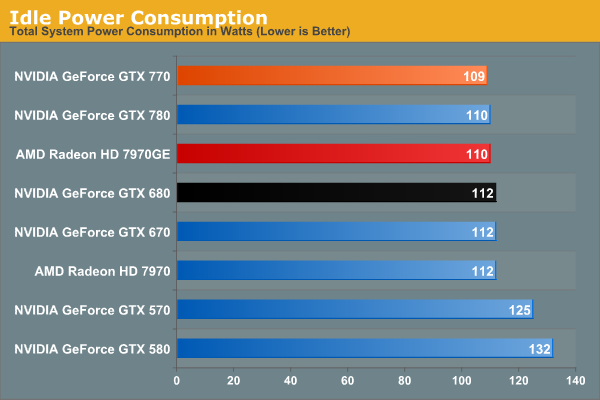
We don’t normally publish this data, but GTX 770 has an extra interesting attribute about it: its idle clockspeed is lower than other Kepler parts. GTX 680 and GTX 780 both idle at 324MHz, but GTX 770 idles at 135MHz. Even 324MHz has proven low enough to keep Kepler’s idle power in check in the past, so it’s not entirely clear just what NVIDIA is expecting here. We’re seeing 1W less at the wall, but by this point the rest of our testbed is drowning out the video card.
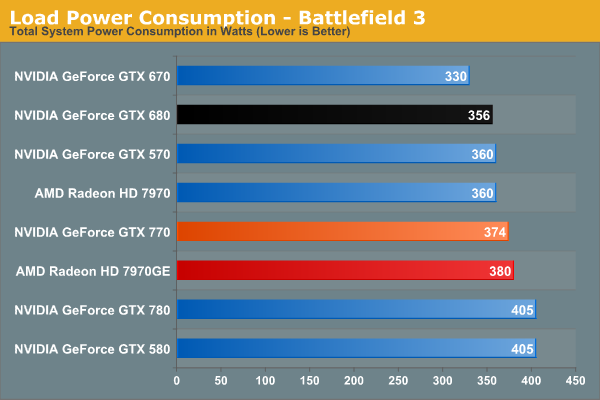
Moving on to BF3 power consumption, we can see the power cost of GTX 770’s performance. 374W at the wall is only 18W more than GTX 680, thanks in part to the fact that GTX 770 isn’t hitting its TDP limit here. At the same time compared to the outgoing GTX 670, this is a 44W difference. This makes it very clear that GTX 770 is not a drop-in replacement for GTX 670 as far as power and cooling go. On the other hand GTX 770 and GTX 570 are very close, even if GTX 770’s TDP is technically a bit higher than GTX 570’s.
Despite this runup, GTX 770 still stays a hair under 7970GE, despite the slightly higher CPU power consumption from GTX 770’s higher performance in this benchmark. It’s only 6W at the wall, but it showcases that NVIDIA didn’t have to completely blow their efficiency curve to get a GK104 card back up to 7970GE performance levels.
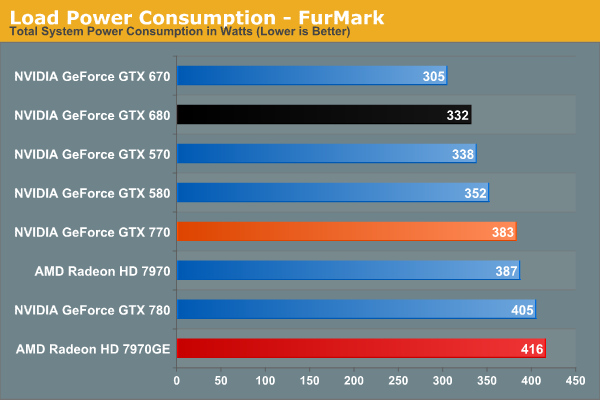
In our TDP constrained scenario we can see the gaps between our cards grow. 78W separates the GTX 770 from GTX 670, and even GTX 680 draws 41W less, almost exactly what we’d expect from their published TDPs. On the flip side of the coin 383W is still less than both 7970 cards, reflecting the fact that GTX 770 is geared for 230W while AMD’s best is geared for 250W.
This is also a reminder however that at a mid-generation product extra performance does not come for free. With the same process and the same architecture, performance increases require power increases. This won’t significantly change until we see 20nm cards next year.
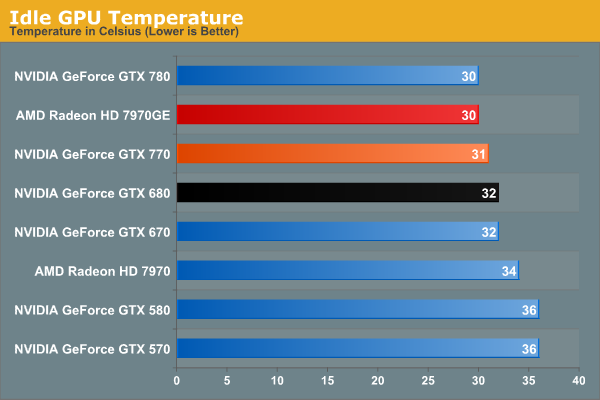
Moving on to temperatures, these are going to be a walk in the part for the reference GTX 770 due to the Titan cooler. At idle we see it hit 31C, which is actually 1C warmer than GTX 780, but this really just comes down to uncontrollable variations in our tests.
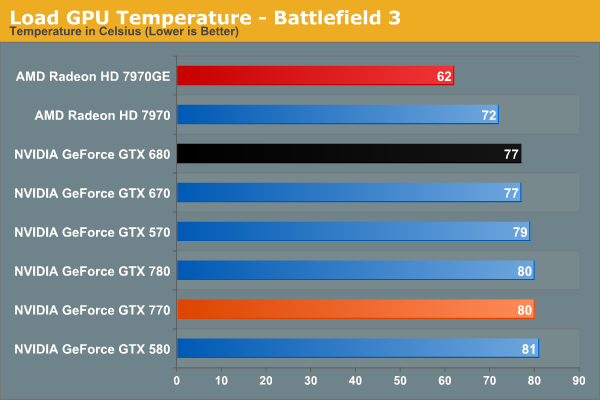
As a GPU Boost 2.0 card temperatures will top out at 80C in games, and that’s exactly what happens here. Interestingly, GTX 770 is just hitting 80C, as evidenced by our clockspeeds earlier. If it was running hotter, it would have needed to drop to lower clockspeeds.
Of course it doesn’t hold a candle here to 7970GE, but that’s the difference between a blower and an open air cooler in action. The blower based 7970 is much closer, as we’d expect.
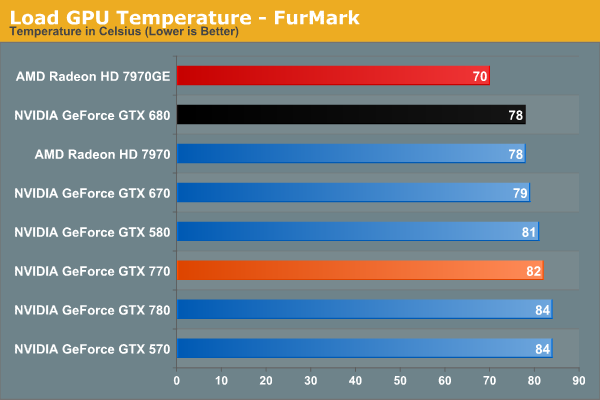
Under FurMark the temperature situation is largely the same. The GTX 770 comes up to 82C here (favoring TDP throttling over temperature throttling), but the relative rankings are consistent.
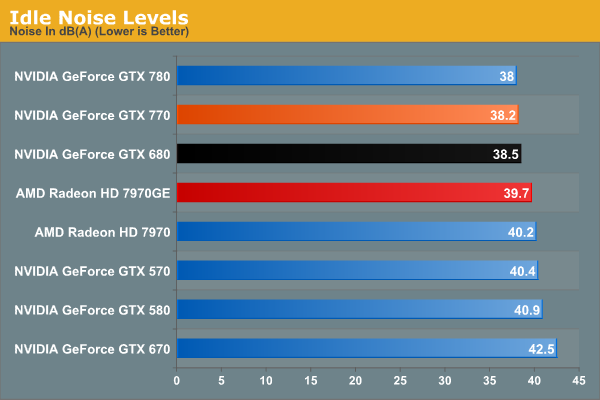
With Titan’s cooler in tow, idle noise looks very good on GTX 770.
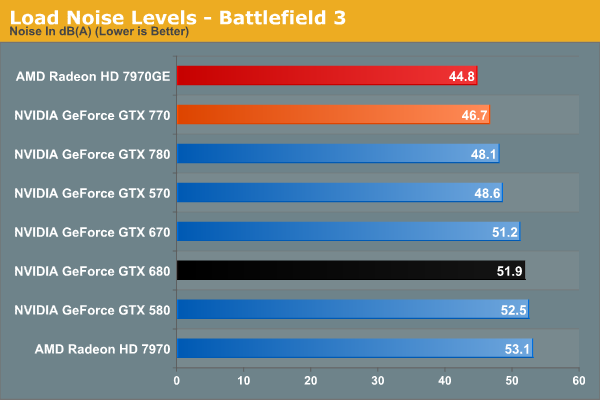
Our noise results under Battlefield 3 are a big part of the reason we’ve been calling the Titan cooler oversized for GTX 770. When is the last time we’ve seen a blower on a 230W card that only hit 46.7dB? The short answer is never. GTX 770’s fan simply doesn’t have to rev up very much to handle the lesser heat output. In fact it’s damn near competitive with the open air cooled 7970GE; there’s still a difference, but it’s under 2dB. More importantly however, despite being a more powerful and more power-hungry card than the GTX 680, the GTX 770 is over 5dB quieter, and this is despite the fact that the GTX 680 is already a solid card own its own. Titan’s cooler is certainly expensive, but it gets results.
Of course this is why it’s all the more a shame that none of NVIDIA’s partners are releasing retail cards with this cooler. There are some blowers in the pipeline, so it will be interesting to see if they can maintain Titan’s performance while giving up the metal.
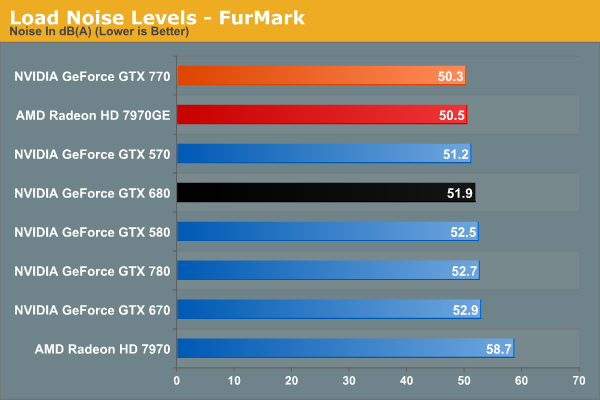
With FurMark pushing our GTX 770 at full TDP, our noise results are still good, but not as impassive as they were under BF3. 50.3dB is still over a dB quieter than GTX 680, though obviously much closer than before. On the other hand the GTX 770 ever so slightly edges out the 7970GE and its open air cooler. Part of this comes down to the TDP difference of course, but beating an open air cooler like that is still quite the feat.
Wrapping things up here, it will be interesting to see where NVIDIA’s partners go with their custom designs. GTX 770, despite being a higher TDP part than both GTX 670 and GTX 680, ends up looking very impressive when it comes to noise, and it would be great to see NVIDIA’s partners match that. At the same time the increased power consumption and heat generation relative to the GeForce 600 series is unfortunate, but not unexpected. But for buyers coming from the GeForce 400 and GeForce 500 series, GTX 770 is in-line with what those previous generation cards were already pulling.










117 Comments
View All Comments
Catalina588 - Thursday, May 30, 2013 - link
Folding@Home Big-Time Discrepancy in reviewsCan anyone explain the material differences between this review's Compute Results for Folding@Home and the same FAHbench run at Tom's Hardware?
http://www.tomshardware.com/reviews/geforce-gtx-77...
Since FAHbench is self-contained -- load and go -- it's hard to figure how the results could be so different.
Ryan Smith - Thursday, May 30, 2013 - link
We're using a newer version of the benchmark, 1.2. FAHBench 1.2 has some very big performance optimizations that aren't in 1.1x.kyuu - Thursday, May 30, 2013 - link
Not bad, but I think I'd still just find a 7970 with a good cooler on sale and overclock the crap out of it if I was looking to buy a high-end GPU.Lt_dan - Thursday, May 30, 2013 - link
People should be looking at other websites. This review is showing scores that don't even make sense. The 7970, on bf3, has the same score as tomshardware's review of the 680, which was done over the year ago.azixtgo - Thursday, May 30, 2013 - link
nobody cares. If this were ~$300 I'd seriously consider it. But getting a 7950 for ~$300 along with 4 quality games just makes me not care about a $400 card thats already out of my budget anyway. Nvidia always keeps their best just too high. At 400 its competing in value against a card with more to offer. They don't have the concept of winning by pricing right, but I guess they've never had to go there like AMD did.Razorbak86 - Thursday, May 30, 2013 - link
Just because YOU don't care, doesn't mean that NOBODY cares. Please don't attempt to speak for the rest of us.agentwax - Thursday, May 30, 2013 - link
Hmm recently built a system with gigabyte 670 and was looking to go sli in the near future. Upon reading this review I'm second guessing. Should I get a second 670 in a few months and go sli Or a 770 and go sli some time around christmas? Very happy with temps and noise on gigabyte wind force 670thunderising - Friday, May 31, 2013 - link
Now it's time for a HD 7970 GHZ GHZ MEGA GHZ edition with faster clocks and a new driver release for improved performance. HeheheAt least that would be better than a HD8950 = HD 7970 with faster clock speeds.
evolucion8 - Friday, May 31, 2013 - link
That is not correct. The HD 7970 has a bigger bus, but being 28nm instead of 40nm like the HD 6970 means that the HD 7970 was able to achieve great performance gains by being 354mm2 compared to the HD 6970 which is around 389mm2colonelclaw - Friday, May 31, 2013 - link
Is anyone else as disappointed as I am about pricing all the way across the board with this new generation? As an owner of a GTX580 I was thinking it's about time for an upgrade, but all these high end cards look 100 $/£/€ overpriced to me. I wasn't happy about paying £450 for my 580 but there's no way in hell I'm prepared to pay £550 for the 780, and the 770 isn't a big enough upgrade to interest me.I'm more than a little suspicious that AMD and NVidia are agreeing on price points in order to make larger profits. Having just 2 companies in a market sector makes it pretty easy for them to do this.